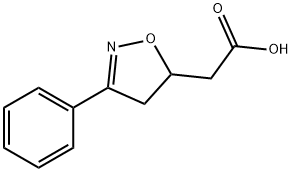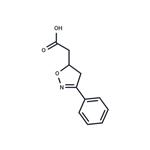Description
VGX-1027 (6501-72-0) is an immunomodulator that inhibits secretion of IL-1β, TNF-α, and IL-10 from murine macrophages stimulated with LPS and spares T cell function.1?Ameliorates the course of acute and chronic immunoinflammatory conditions such as carrageenan-induced pleurisy, LPS-induced lethality, and type II collagen-induced arthritis in mouse models.1?Prevents spontaneous and accelerated forms of autoimmune diabetes in a NOD mouse model.2?Modulates genes involved in LPS-induced Toll-like receptor 4 activation in a mouse Lupus model.3?Displays protective effects in particulate matter-induced acute lung injury by blocking TLR4 signaling.4
Uses
2-(3-Phenyl-4,5-dihydroisoxazol-5-yl)acetic Acid reduces the secretion of IL-1β, TNF-α and IL-10 from purified murine macrophages but not of T cells; and reduces the activation of NF-κB and p38 MAP kinase pathways along with up-regulation of ERK pathways. 2-(3-Phenyl-4,5-dihydroisoxazol-5-yl)acetic Acid inhibits proliferation of enterobacterial antigen-reactive CD4+CD25- T cells in vitro .
References
1) Stojanovic?et al.?(2007),?In vitro, ex vivo and in vivo immunopharmacological activities of the isooxazoline compound VGX-1027: modulation of cytokine synthesis and prevention of both organ-specific and systemic autoimmune diseases in murine models; Clin. Immunol.,?123?311
2) Stosic-Grujisic?et al.?(2007),?A potent immunomodulatory compound, (S,R)-3-Phenyl-4,5-dihydro-5-isoxazole acetic acid, prevents spontaneous and accelerated forms of autoimmune diabetes in NOD mice and inhibits the immunoinflammatory diabetes induced by multiple low doses of streptozotocin in CBA/H mice; J. Pharmacol. Exp. Ther.,?320?1038
3) Fagone?et al.?(2014),?VGX-1027 modulates genes involved in lipopolysaccharide-induced Toll-like receptor 4 activation and in a murine model of systemic lupus erythematosus; Immunology,?142?594
4) Xu?et al.?(2019),?Protective effects of VGX-1027 in PM2.5-induced airway inflammation and bronchial hyperresponsiveness; Eur. J, Pharmacol.,?842?373



